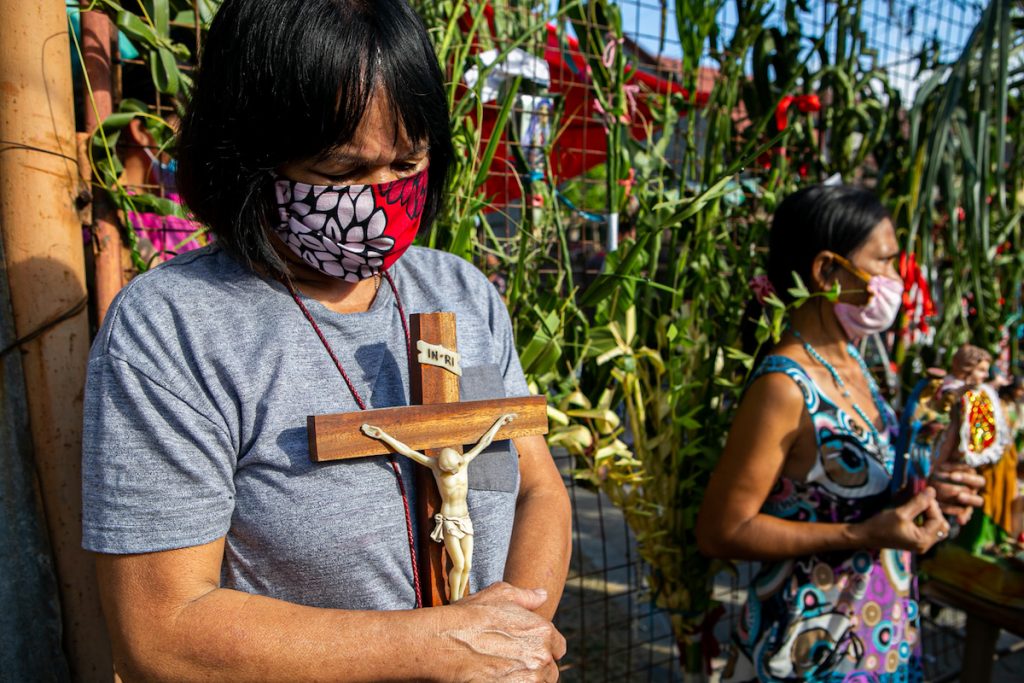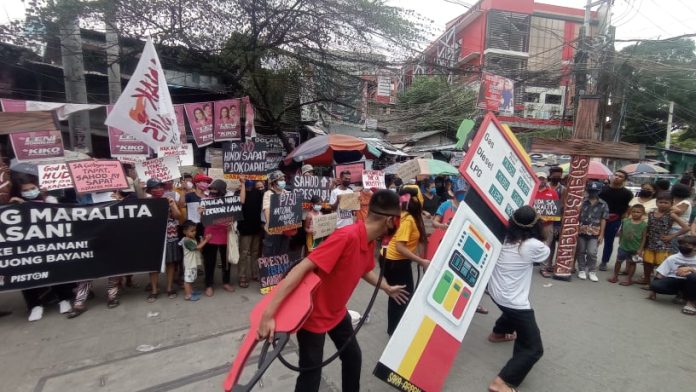A group of urban poor dwellers in the Philippine capital staged their own version of the passion of Jesus on Friday, April 8, to dramatize what they described as the “plight of the masses.”
“Sunud-sunod ang pandurukot at iba pang karanasan sa maralitang mamamayan (The abduction and other attacks on the urban poor continue),” said urban poor leader Mimi Doringo of the group Kadamay.
During the protest march to recall Jesus’ “Way of the Cross,” a passenger jeep was “crowned with thorns” at a gas station, a stop was made at a public market, and demonstration was held outside the office of the Bureau of Internal Revenue.
Playing the role of Jesus was a jeepney driver whipped by gas pumps that reflect the high prices of petroleum products.
Effigies of President Rodrigo Duterte and presidential candidate Ferdinand Marcos Jr. were seen “pushing” the companies to punish the jeepney driver.
In a short prayer, the protesters narrated their experiences under what they said was the “betrayal” of the Duterte government that they likened to how Judas sold Jesus to the Romans.
Pump prices of petroleum products went up 12 times already since January on the back of the Russia-Ukraine war.
Various groups, including the government’s Energy department, have proposed to suspend the excise tax to lessen oil prices, but Duterte rejected the proposal, saying it will make the economy suffer.
The president instead pressed the government to provide a P200 monthly subsidy to the bottom 50 percent of the population.
Doringo of Kadamay urged urban poor dwellers to make “wise choices and remember the suffering they endured” as they observe the Holy Week this year.
“Mabuti pa at magnilay-nilay ang ating mga kababayan kung paano tayo pinahirapan at pinagmalupitan sa nakaraang anim na taon (It is good for us to reflect on how we have been punished and oppressed in the past six years),” she said.
“Nawa’y hindi na maulit ang ganitong klaseng pagsasamantala gayundin ang pang-aaping dinanas natin noong martial law (Hopefully this kind of abuse and the persecution we experienced under martial law will not happen again,” said Doringo.

Holy Week in the Philippines
Holy Week in the Philippines is the time of year when Filipinos troop to the provinces for a long vacation.
The week kicks off bright and early on Palm Sunday morning when Catholics carry palm fronds to be blessed by the priest.
The fronds are later taken home and placed on front doors or windows supposedly to ward off evil spirits.
For many Filipinos, the Easter exodus starts straight after the blessing of fronds. Many take extra time off work to enjoy a weeklong vacation.
Holy or Maundy Thursday and Good Friday are national holidays, but many companies also give employees Wednesday off.
Maundy Thursday starts the Triduum, when Catholics observe the last Mass before Easter or the Institution of the Lord’s Supper. Priests also renew their sacerdotal vows in an elaborate ceremony that attracts thousands.
The washing of the feet of the apostles is reenacted in many churches, followed by the procession of the Blessed Sacrament to the “Altar of Repose.”
The traditional Visita Iglesia or church visit starts after Maundy Thursday rituals. People visit at least seven churches around town, supposedly to meditate on the Way of the Cross.
The trip is also a good excuse for families to go sightseeing.
Because the Blessed Sacrament is exposed on the Altar of Repose, many people stay out all night, some praying inside churches, many outside, enjoying the summer breeze in their town square.
Good Friday observance is usually observed with the Way of the Cross, the Siete Palabras or Seven Last Words, delivered by the best and most eloquent speakers, including politicians, actors, and priests.
A passion play called the Senakulo is staged in the afternoon, followed by a procession of devotees and flagellants who sometimes have themselves nailed on crosses, supposedly as expressions of penance.









